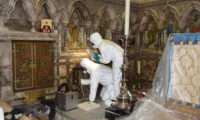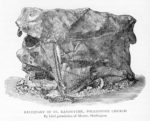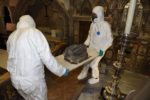 Bones found in a lead reliquary in a church in Folkestone, Kent, have been identified as almost certainly belonging to 7th century Anglo-Saxon princess Saint Eanswythe. The surviving remains, about half of a skeleton, were studied by a team of scientists for five days. A temporary laboratory was set up in the church which was closed to the public for the duration.
Bones found in a lead reliquary in a church in Folkestone, Kent, have been identified as almost certainly belonging to 7th century Anglo-Saxon princess Saint Eanswythe. The surviving remains, about half of a skeleton, were studied by a team of scientists for five days. A temporary laboratory was set up in the church which was closed to the public for the duration.
 The study found that the bones all belonged to one individual, probably a woman, between 17 and 20 years old at the time of her death. The bones were healthy, showing no signs of childhood malnutrition. Radiocarbon analysis of a tooth and foot bone found the person had likely died in the middle of the 7th century.
The study found that the bones all belonged to one individual, probably a woman, between 17 and 20 years old at the time of her death. The bones were healthy, showing no signs of childhood malnutrition. Radiocarbon analysis of a tooth and foot bone found the person had likely died in the middle of the 7th century.
 The reliquary was rediscovered in June 1885 in the north wall of the high chancel during a renovation. Masons were removing the plaster cladding on the wall in order to install new alabaster panels when they discovered a large arched opening with a stone slab four feet long and two feet wide at the base of the arch.
The reliquary was rediscovered in June 1885 in the north wall of the high chancel during a renovation. Masons were removing the plaster cladding on the wall in order to install new alabaster panels when they discovered a large arched opening with a stone slab four feet long and two feet wide at the base of the arch.
Underneath the slab, workers found a cavity containing a lead coffer about 14 inches long, nine inches wide and eight inches high. The coffer was decorated with dots arranged in lozenge patterns, a motif also seen in the lead cists of Norman nobleman William de Warenne, 1st Earl of Surrey, and his wife Gundred who died in 1088 and 1085 respectively and were buried at Lewes Priory, the Cluniac monastery they had founded.
 Inside the leaden coffer were skeletal remains. The location where they were laid to rest would have been the spot of highest honor in the church, the kind of place reserved for the church’s founder or its greatest patron. The chancel walls date to the 12th or 13th century. When it was first constructed, this arched space was open to the chancel. At some point it was filled with stone and walled up.
Inside the leaden coffer were skeletal remains. The location where they were laid to rest would have been the spot of highest honor in the church, the kind of place reserved for the church’s founder or its greatest patron. The chancel walls date to the 12th or 13th century. When it was first constructed, this arched space was open to the chancel. At some point it was filled with stone and walled up.
Eanswythe was born around 630, daughter of King Eadbald of Kent and his Frankish wife Emma or Ymme. They were both Christian — Eadbald was a fresh convert when they married — and their daughter was said to have founded the first women’s monastery in England, the Benedictine Folkestone Priory. Refusing offers of marriage, she lived in the community until her premature death around 650.
 The Folkstone Priory was abandoned in the 10th century when the cliff upon which it was perched became so eroded by the sea that the building fell to ruin. After the Norman Conquest, a new priory was built further inland in 1137 along with the church of St. Mary and St. Eanswythe. The remains of one of its namesakes were translated to the new church on Saint Eanswythe’s day, September 12, 1138. That’s when the lead coffer was decorated with the lozenge pattern used on the de Warenne cists 40 years earlier.
The Folkstone Priory was abandoned in the 10th century when the cliff upon which it was perched became so eroded by the sea that the building fell to ruin. After the Norman Conquest, a new priory was built further inland in 1137 along with the church of St. Mary and St. Eanswythe. The remains of one of its namesakes were translated to the new church on Saint Eanswythe’s day, September 12, 1138. That’s when the lead coffer was decorated with the lozenge pattern used on the de Warenne cists 40 years earlier.
The priory was destroyed during the Dissolution of the Monasteries. The church survived as the Folkestone Parish Church. It’s possible the chancel arch was filled with rubble at this time and the reliquary deliberately obscured for its own protection. After the rediscovery of the reliquary, Rev. M. Woodward, Vicar of Folkestone, returned it to the niche in the wall, only now it was lined with alabaster and covered with a brass grill. The grill was then covered with a door which when open would allow people to look through the grill at the lead coffer.
[Andrew Richardson, of the Canterbury Archaeological Trust] said the result of the analysis was of national significance. “It now looks probable that we have the only surviving remains of a member of the Kentish royal family, and one of the earliest Anglo-Saxon saints.
“There is more work to be done to realise the full potential of this discovery. But certainly the project represents a wonderful conjunction not only of archaeology and history, but also of a continuous living faith tradition at Folkestone from the mid-seventh century to the present day.”
Lesley Hardy, the director of the Finding Eanswythe Project at Canterbury Christ Church University, said: “Folkestone is an extremely ancient place but much of its heritage has been erased through development in the 19th and 20th centuries. Eanswythe was at the centre of the community – people would have seen her as a local hero. To bring her back into the light is something quite special.”
The bones have been returned to their niche yet again, but funds will be raised for additional scientific analyses, including DNA testing.
Where tha hack is Earcongota? :confused:
———–
640AD — Her Redbald Cantwara cyning forþferde, ⁊ he ricsode .xxv. wintra. He hæfde twegene sunu Ermenred ⁊ Ercenberht. ⁊ þes Ercenberht rixode æfter his fæder. ⁊ Ermenred gestrynde twegen sunu. þa syððan wurðan gemartirode of Ðunore.
[A.D. 640] In this year, Eadbald, king of the Kentish, died, who was king twenty-five years. He had two sons, Ermenred and Earconbert, and Earconbert reigned there after his father. [He overthrew all idolatry in his kingdom, and was the first of the English kings who established the Easter-fast. His daughter was called Earcongota, a holy woman and a wondrous person, whose mother was Sexberga, daughter of Anna, king of the East-Angles.] And Ermenred begot two sons, who afterwards were martyred by Thunner.
———–
Why is Eanswyth not mentioned as Ed’s daughter, but instead –at least in some of the Chronical manuscripts– his granddaughter Earcongota as holy virgin and a wondrous person?
Apparently, Eanswyth’s Mom was Emma (“Ymma”) from Franconia/ Austrasia.
According to “Þá hálgan” (On the [Resting-Places of the] Saints, mid-11th century):
———-
“Ðonne wæs Ymme, Eadbaldes cwen, Franca cynges dohtor, and hig begeaton sancte Eanswiðe, þe æt Folcanstane restað, and Earcanbriht Cantwara cyningc and Eormenred æþelingc.”
———-
“Emma, Eadbald’s queen, daughter of the Frankish king, and [King Eadbald], they begot St Eanswith, who is buried in Folkstone, and the royal sons Eorcenbriht as Kentish king and Eormenred.”
So far, no news on Earcongota.
Ah, it is good to see my home town in the news :boogie: